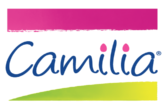Camilia is made from highly diluted solutions of three plants to soothe your baby’s discomfort from teething and sore gums.

German Chamomile
German chamomile (as the homeopathic preparation of Chamomilla officinalis 9C) relieves teething pain accompanied by irritability. There are several types of chamomile but German chamomile is the most common and used in various ways for centuries. German chamomile tea has historically been sipped by adults for its calming effect before bedtime. The homeopathic preparation of this plant with white petals and a yellow center is also used to calm babies during a pain-related tantrum, when one of their cheeks is redder than the other, and they’re pacified by being rocked. Chamomilla 9C also relieves hypersensitivity to pain.

Pokeweed
Pokeweed (as the homeopathic preparation of Phytolacca decandra 5C) relieves red swollen gums with pain radiating to the ears. Native to the United States, poke needs rich, moist and well-drained soils. This weed can easily become invasive. It has shoots and leaves but is known for its berries. Historically the rich blue-colored berries have been used to dye cloth and to color wine and candy. Several small Southern communities hold an annual poke festival in remembrance of the importance of this versatile plant.

Chinese Rhubarb
Chinese Rhubarb (as the homeopathic preparation of Rheum 5C) relieves minor digestive upsets associated with baby teething. This variety of rhubarb is different than the common red stalk found in American gardens and used for pies and jelly. The earliest mention of Rheum dates to 2,700 B.C. in Rha, China where it was used for stomach ailments. Providing a variety of medicinal uses, Rheum was soon a highly coveted item and discovered by other parts of the world along the ancient trade route, the Silk Road.
What is homeopathy?
Homeopathy is a 200-year-old therapeutic method that uses diluted substances to relieve symptoms. The active ingredients in homeopathic medicines include diluted plant or animal extracts or minerals that relieve the same symptoms they cause at full strength. For example, a microdose of a coffee bean helps nervousness.
How to Read the Label?
Active Ingredients:
These are listed in Latin on labels of homeopathic medicines. This is an international packaging standard to identify the exact species.

Homeopathic Dilution Levels:
The Centesimal scale or “C” means that each dilution is 100 times more diluted than the previous one. The 5C and 9C on Camilia’s label indicates how many times the plants were diluted using this process. For instance, 5C is 100 times more diluted than 4C.

HPUS:
The Homeopathic Pharmacopoeia of the United States defines the production and usage standards recognized by the federal government. Parents should look for this acronym on labels of homeopathic products. It ensures consumers that the ingredients were prepared according to the high standards of this official reference.

Ensuring Quality
Since 1932, the Boiron family has focused on improving manufacturing to ensure its medicines are available at a consistent pharmaceutical-grade quality in more than 50 countries. Industrial tools were developed for the unique manufacturing process. Each year, the quality control team of 60 staff members conducts about 30,000 tests during the manufacturing process.

